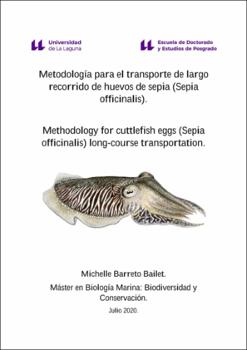Metodología para el transporte de largo recorrido de huevos de sepia (Sepia officinalis).
Author
Barreto Bailet, MichelleDate
2021Abstract
Sepia officinalis está ganando impulso como especie objetivo en la acuicultura actual. Es por
ello que surge la necesidad de crear una metodología de transporte de los huevos de estos
animales. En este estudio, se determinaron las condiciones óptimas para la realización de este
transporte. En primer lugar, se analizaron tres tipos de contenedores, concluyendo que la caja
de poliestireno correspondiente a la marca PMED48 es la más adecuada para el transporte.
Además, dicho transporte deberá realizarse con una biomasa máxima de 50 huevos con O2 puro
como tipo de oxigenación, puesto que se ha demostrado que de esto modo, se obtienen las
mejores tasas de eclosión tras el transporte. Finalmente, se determinó la necesidad de un tampón
para amortiguar las bajadas de pH que sufre el agua durante el transporte debido a la excreción
de productos de desecho (amonio y CO2), concluyendo que el tampón Turtle PortugalPet –
Portugal, con CaCO3, es el más adecuado. Sepia officinalis is increasing in popularity as a target species in today's aquaculture. This is the
reason why we need to create a methodology for transporting the eggs of these animals. In this
study, the optimal conditions for carrying out this transport were analysed. Firstly, three types
of containers were analysed, concluding that the styrofoam box corresponding to the PMED48
is the most suitable for transport. Furthermore, this transport should be carried out with a
maximum biomass of 50 eggs with pure O2 as the oxygenation type, since it has been
demonstrated that this way, the best hatching rates have been obtained after transport. Finally,
it was determined that a buffer is needed to maintain the pH drops that the water suffers during
transport due to the excretion of waste products (ammonia and CO2), concluding that the Turtle
PortugalPet - Portugal buffer, with CaCO3, is the most suitable.




